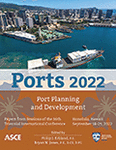21st Century Opportunities, Hazards, Roles, and Responsibilities Facing the Nation’s Water Resources
Publication: Ports 2022
ABSTRACT
Communities around the world have historically formed around access to water for drinking, agriculture, and transportation. Societal and individual project decisions affecting water are continually made, with significant decisions made generations ago continuing to influence current conditions just as current infrastructure investments will influence future generations. Conditions are not static, however. Land use changes, population migration, shifting cultural norms, increased effects of climate change, and the interdependency of supply chains all affect the sufficiency and resilience of water infrastructure. An appropriate balance of needs during planning, design, and recapitalization is both extremely important and difficult. All levels of government, stakeholder communities, and private citizens have roles and responsibilities which sometimes converge but often compete. Acceptable “resilient enough” performance levels vary widely based on who owns the risk of failure and their experience with past disasters. There is a need for resilience and sustainability expectations, particularly in and around natural water resources, to be baselined, shared, taught, and codified to support both technical designers, political decision-makers, and the electorate.
Get full access to this article
View all available purchase options and get full access to this chapter.
REFERENCES
Allen, M., L. Gillespie-Marthaler, M. Abkowitz, and J. Camp. (2020). “Evaluating flood resilience in rural communities: a case‑based assessment of Dyer County, Tennessee”, Natural Hazards, Springer, https://doi.org/10.1007/s11069-020-03868-2.
ASCE. (2009). “Guiding Principles for the Nation’s Critical Infrastructure”, American Society of Civil Engineers, Reston, Available from https://ascelibrary.org/doi/book/10.1061/9780784410639, Last Accessed 16 November 2021.
Austin, N. (2019, June 6). “Midwest flooding ripples through economy, transportation”, Freightwaves. https://www.freightwaves.com/news/midwest-flooding-ripples-through-economy-transportation.
Campbell, A. L. (2018). “After the Storm: Understanding and Improving U.S. and Texas Disaster Recovery and Hazard Mitigation Policies”, Texas A&M J. of Property Law, Vol 5: No 2, pp 107–137, https://doi.org/10.37419/JPL.V5.I2.1.
Carlton, J. (2018, August 13). “As Texas Recovers From Harvey, Port Arthur Struggles”, The Wall Street Journal. https://www.wsj.com/articles/as-texas-recovers-from-harvey-port-arthur-struggles-1534152600.
Dundon, L. A., and J. S. Camp. (2021). “Climate justice and home-buyout programs: renters as a forgotten population in managed retreat actions”, Journal of Environmental Studies and Sciences, Springer, (2021) 11:420–433, https://doi.org/10.1007/s13412-021-00691-4.
FEMA. (2021). “FEMA Announces Initial Initiatives to Advance Climate Change Resilience” https://www.fema.gov/print/pdf/node/627890. Last Accessed 16 November 2021.
Flitter, E., and R. Valdmanis. (2017, September 15). “Oil and chemical spills from Hurricane Harvey big, but dwarfed by Katrina”, Reuters. https://www.reuters.com/article/us-storm-harvey-spills/oil-and-chemical-spills-from-hurricane-harvey-big-but-dwarfed-by-katrina-idUSKCN1BQ1E8.
GAO. (2021). “Disaster Resilience, FEMA Should Take Additional Steps to Streamline Hazard Mitigation Grants and Assess Program Effects”, US Government Accountability Office, Washington DC, GAO-21-140.
National Academies of Sciences, Engineering, and Medicine. (2019). Freight Transportation Resilience in Response to Supply Chain Disruptions, Washington DC, The National Academies Press, https://doi.org/10.17226/25463.
National Academies of Sciences, Engineering, and Medicine. (2020). Strengthening Post-Hurricane Supply Chain Resilience: Observations from Hurricanes Harvey, Irma, and Maria, The National Academies Press, Washington, DC, https://doi.org/10.17226/25490.
National Academies of Sciences, Engineering, and Medicine. (2021). Motivating Local Climate Adaptation and Strengthening Resilience: Making Local Data Trusted, Useful, and Used, The National Academies Press, Washington, DC, https://doi.org/10.17226/26261.
Nelson, K. S., M. D. Abkowitz, and J. V. Camp. (2015). “A method for creating high resolution maps of social vulnerability in the context of environmental hazards”, Applied Geography, Elsevier, https://doi.org/10.1016/j.apgeog.2015.06.011.
NOAA. (2021). “U.S. Billion-Dollar Weather &Climate Disasters 1980-2021”, NOAA National Centers for Environmental Information, Available from https://www.ncdc.noaa.gov/billions/events.pdf, Last Accessed 16 November 2021.
USACE. (2021). “USACE Climate Action Plan”, US Army Corps of Engineers, Washington DC, Available from https://usace.contentdm.oclc.org/digital/collection/p16021coll11/id/5381, Last Accessed 16 November 2021.
US Census Bureau. (2020). Jefferson County, Texas and Harris County, Texas Profiles, https://data.census.gov/cedsci/table?q=Jefferson%20County,%20Texas&tid=DECENNIALPL2020.P1, Last Accessed 16 November 2021.
USCG (US Coast Guard). (2019). “Impacts of the 2019 Upper Mississippi River Flooding on Barge Movements in the Upper Midwest Region”, https://www.dco.uscg.mil/Portals/9/Impacts%20of%202019%20UMR%20Flooding_Barge%20Movements_Fahie_1.pdf.
USDOT. (2021). “Climate Action Plan, Revitalizing Efforts to Bolster Adaptation & Increase Resilience”, US Department of Transportation, Washington, DC. https://www.sustainability.gov/adaptation/.
Information & Authors
Information
Published In
History
Published online: Sep 15, 2022
Authors
Metrics & Citations
Metrics
Citations
Download citation
If you have the appropriate software installed, you can download article citation data to the citation manager of your choice. Simply select your manager software from the list below and click Download.
